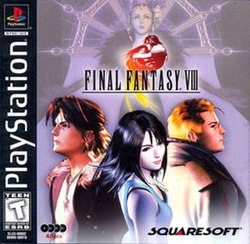Winhill
| Final Fantasy VIII | |
|---|---|

North American box art showing (from left): Squall, Rinoa, and Seifer, with Edea in the background
|
|
| Developer(s) | Square |
| Publisher(s) | |
| Distributor(s) | Eidos Interactive |
| Director(s) | Yoshinori Kitase |
| Producer(s) | Shinji Hashimoto |
| Designer(s) | Hiroyuki Ito |
| Programmer(s) | Ken Narita |
| Artist(s) | Yusuke Naora |
| Writer(s) | Kazushige Nojima |
| Composer(s) | Nobuo Uematsu |
| Series | Final Fantasy |
| Platform(s) | PlayStation, Microsoft Windows |
| Release date(s) | |
| Genre(s) | Role-playing |
| Mode(s) | Single-player |
| Aggregate scores | |
|---|---|
| Aggregator | Score |
| GameRankings | PS: 89% PC: 80% |
| Metacritic | PS: 90/100 |
| Review scores | |
| Publication | Score |
| CGW | 2/5 |
| Edge | 9/10 |
| EGM | 95/100 |
| Famitsu | 37/40 |
| GameSpot | PS: 9.5/10 PC: 6.7/10 |
| GameSpy | 90/100 |
| IGN | PS: 9/10 PC: 7.4/10 |
| Maximum PC | 9/10 |
| PSM | 10/10 |
| Awards | |
|---|---|
| Publication | Award |
| Electronic Gaming Monthly | Game of the Year (Readers' Choice) |
| IGN | Best RPG of E3 1999 |
| Computer Gaming World | 20th Best Game of 2000 |
| IGN | 7th Best PlayStation Game |
Final Fantasy VIII (ファイナルファンタジーVIII Fainaru Fantajī Eito?) is a role-playing video game developed and published by Square for the PlayStation console. Released in 1999, it is the eighth main installment in the Final Fantasy series. Set on an unnamed fantasy world with science fiction elements, the game follows a group of young mercenaries, led by Squall Leonhart, as they are drawn into a conflict sparked by the sorceress Edea. After defeating Edea, the protagonists learn that she was under the control of Ultimecia, a sorceress from the future who wishes to compress time. During the quest to defeat Ultimecia, Squall struggles with his role as leader and develops a romance with one of his comrades, Rinoa Heartilly.
Development began in 1997, during the English localization of Final Fantasy VII. The game builds on the visual changes brought to the series by Final Fantasy VII, including use 3D graphics and pre-rendered backgrounds, while also departing from many Final Fantasy traditions. It is the first Final Fantasy to use realistically proportioned characters consistently, feature a vocal piece as its theme music, forego the use of magic points for spellcasting, and deviate from the series' traditional means of increasing a character's power.
Final Fantasy VIII was mostly well received by critics, who praised its originality and visuals while criticizing some of its gameplay elements. It was voted the 22nd-best game of all time in 2006 by readers of the Japanese magazine Famitsu. The game was a commercial success; 13 weeks after its release, Final Fantasy VIII had earned more than US$50 million in sales, making it the fastest-selling Final Fantasy title until Final Fantasy XIII, a multi-platform release. It was later ported to Windows-based personal computers and became available on PlayStation Network as a PSone Classics title in 2009. As of December 2013, it has sold more than 8.5 million copies worldwide.
...
Wikipedia
